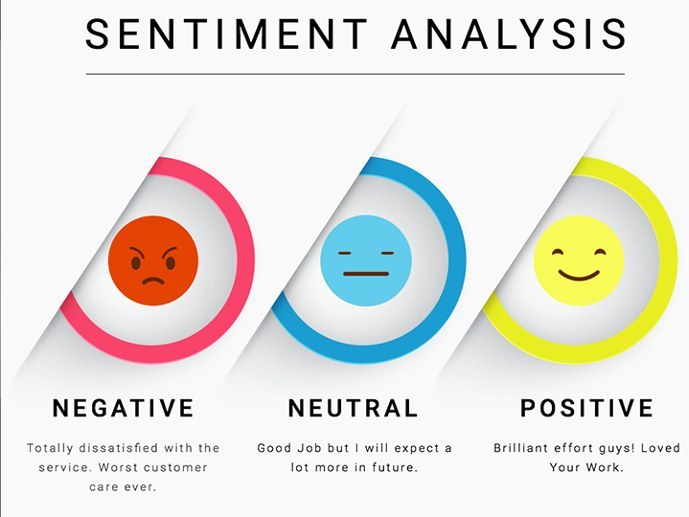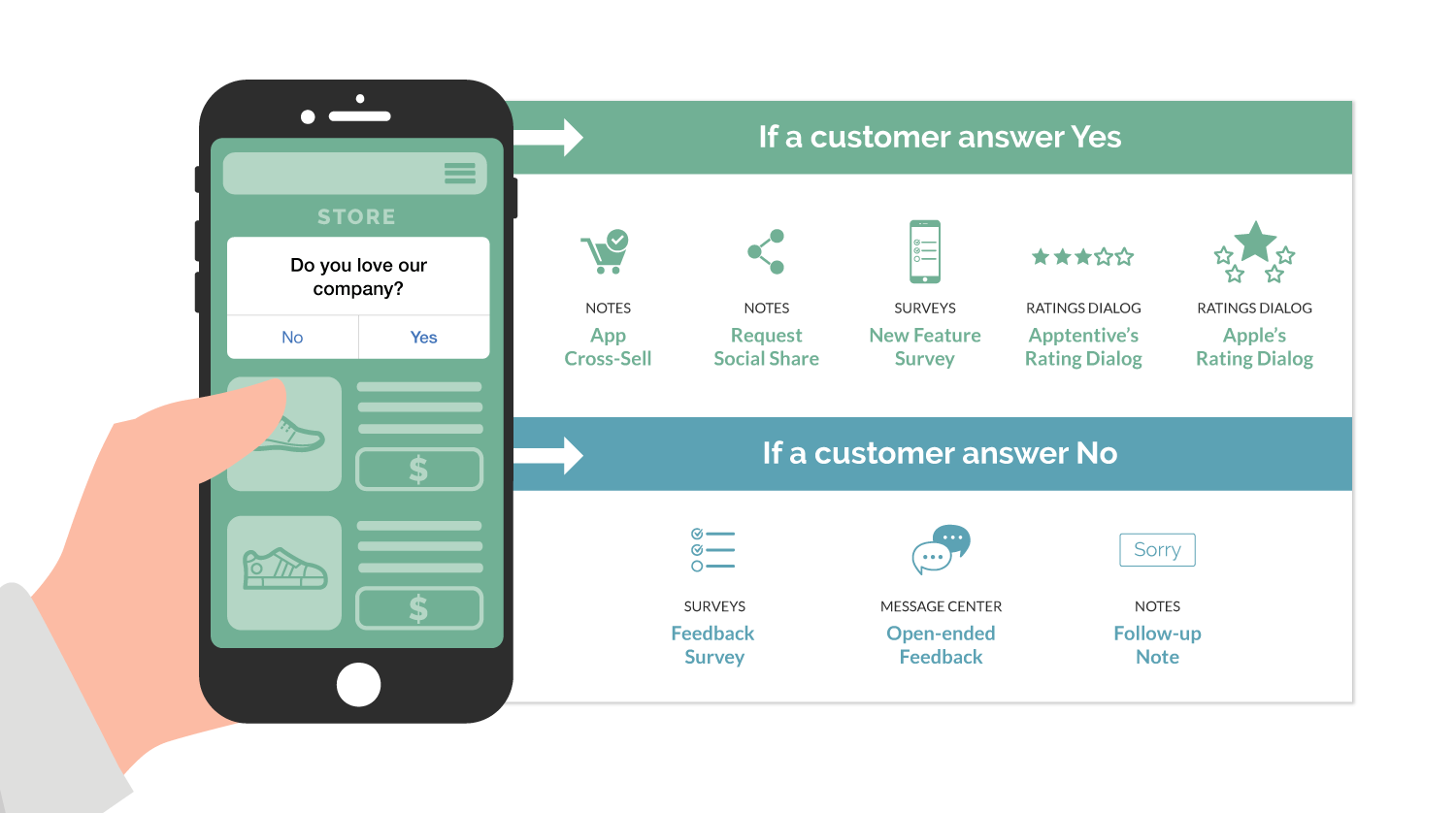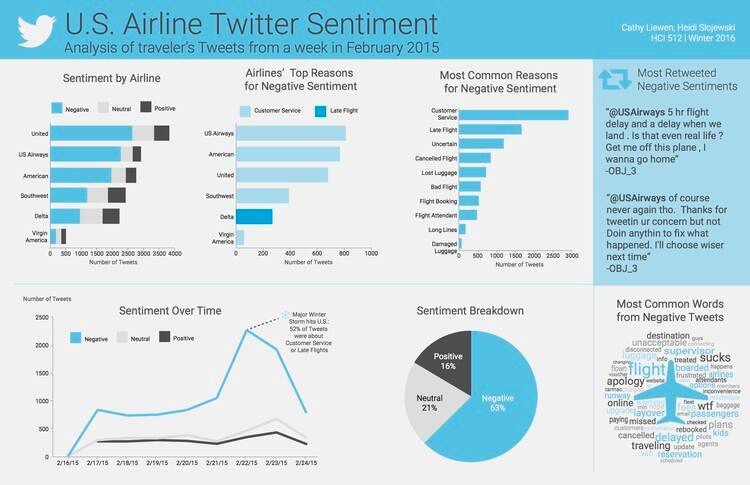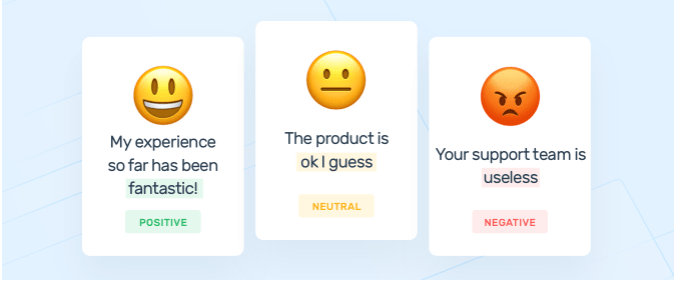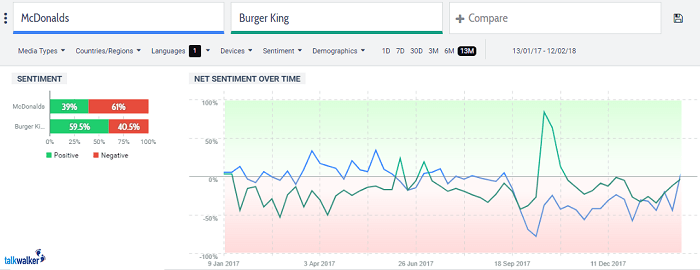A Guide to Customer Sentiment Analysis (and Why It Matters)
- September 30, 2020
- 10 mins read
- Listen

Customer sentiment refers to the different emotions that your customers go through, positive or negative while engaging with your brand. But why is customer sentiment important for brands today?
Studies have shown that your customers are likely to spend 140% more after having a positive experience with your brand. Also, unhappy customers are likely to tell an average of 16 people about their negative experiences, as compared to happy customers who are likely to tell just 9 people!
Customer sentiment analysis is crucial to deduce the different emotions that your customers are having while exploring your products and services. Sentiment analysis metrics can provide you with eye-opening insights, which in turn can help you offer more of what makes your customers happy.
Through customer sentiment analysis, you can improve your customer satisfaction index, customer loyalty, and customer lifetime value multiple folds, and thus maximize the profits for your business.
What is customer sentiment analysis?
Customer sentiment analysis is the process of automatic detection of emotions when customers interact with your products, services, or brand. Customer sentiment analysis is done through Natural Language Processing (NLP) or a set of algorithms that can detect whether the customers’ emotions are positive, negative, or neutral.
Customer sentiment analysis algorithms primarily use two parameters to analyze customer communications and categorize them:
- Polarity – indicates whether the emotions are positive or negative.
- Magnitude – indicates how strong are the emotions exhibited by the customer.
Why is customer sentiment analysis important? (Benefits and Use cases)
Customer sentiment analysis is used by numerous businesses today to improve customer experiences and thus increase their profits.
Here are a few benefits and use cases of customer sentiment analysis that will help you understand its importance and relevance:
Better Customer Service:
One in every three customers is likely to leave your brand after one bad experience. Top-notch customer service is extremely important for the profitability of businesses. Using customer service feedback for customer sentiment analysis can be extremely helpful for your business. It provides insights into how and why customers have negative emotions and completely eliminates the factors that contribute to negative experiences.
Increased return on investment (RoI) from marketing campaigns
Using customer sentiment analysis can help you to accurately deduce your customers’ emotions towards your products and services. You can analyze customer sentiments towards your competitors’ products and thus finetune your product release. It helps you get customer data analytics to gain better results from your marketing campaigns.
Improved products and services
Sentiment analysis can help you anticipate industry trends, gain insights about new markets, and understand what did not go well with your product releases. You can use these insights when you are trying to venture into a new market, releasing new products, or while upgrading your existing products.
Better brand reputation management
Another use case of customer sentiment analysis can be brand monitoring on all online platforms that can help you manage brand reputation better. For instance, monitoring and sentiment analysis of your brand mention on social media, product reviews, forums, etc. can help you quickly stop negative PR from escalating.
How to do customer sentiment analysis? (Examples & Best practices)
The importance of customer sentiment analysis and its use cases must be clear by now. Here are a few ways in which customer sentiment analysis can be done:
1. Gather customer feedback through live chat
For businesses, customer data management is key to offering great experiences. It is also helpful for understanding customers better. That’s why collecting customer data through live chat can be highly effective in training or testing your customer sentiment model to be more accurate. Such customer feedback can be gathered:
- After customer service tickets are resolved.
- After new products are launched.
- Right after the onboarding process is completed.
Here are a few ways using which you can collect accurate customer information through live chats:
- Ask for customer feedback on as many touchpoints as possible to gain accurate information on customer sentiments. Try to gain accurate and timely feedback at the end of every live chat session with customers.
- Feedback collected from live chat can be useful for segregating customers as “promoters”, “passives”, or “detractors”. Promoters are the most desirable, loyal customers and have the highest lifetime value (LTV) who boost your business revenue significantly.
- When the feedback data collected is fed to the customer sentiment analysis model, you can identify the scenarios which lead to more “promotors” sentiments amongst customers. You can understand the common factors that lead to positive customer experience.
- Consumer sentiment analysis tools will also lead you to the common negative experiences and pain points that your customers frequently face.
- Modify your products, features, or services based on the sentiment analysis metrics. Provide more of the desirable factors that led to good customer experiences and eliminate the negative ones completely making it a strong customer retention strategy for your business.
2. Use social media for customer sentiment analysis
Social media can again be a helpful tool to gather valuable customer data for sentiment analysis. Social media platforms such as Facebook, Instagram, and Twitter are a major resource for collecting data because customers tend to be more expressive on such platforms.
Customers use positive words such as “good”, “excellent” or negative words such as “awful”, “hate” against your brand mentions on social media.
Such insights can be collected through social media Application Programming Interfaces (APIs) provided by these social media networks. You can collect real-time data as well as historical brand mentions using such APIs.
Source
A good example will be customer sentiment analysis on phone carriers in the U.S. done by MonkeyLearn on Twitter, which helped them learn insightful things about how their customers were feeling. MonkeyLearn’s findings revealed that a “friendlier, younger take on social media elicits positive responses, in turn improving customer satisfaction”. The results also revealed that most of the complaints received by different phone carriers were the same.
3. Understand customer sentiments by using online surveys
Online surveys can be used to gain extensive customer data based on their experiences with your brand, products, and services. You can use online surveys to gather customer data right after the onboarding process, during the middle of the customer journey, or even from your long-time customers.
Online survey data, when fed to customer sentiment analysis models, can help you understand what features or traits for your brand helped you gain customers’ loyalty. Or, even understand what negative experiences led to increased churn rates.
For example, if an online survey’s results reveal that customers are exhibiting negative sentiments towards a particular feature of your product, it’s time for you to upgrade that feature and make it better.
4. Monitor product reviews and ratings
Product ratings and reviews can be found on various social platforms such as Google Play, Amazon, and other forms. Such product reviews can be a gold mine for you to gather data about products and use them for customer sentiment analysis.
- You can collect competitor product reviews from online platforms, run it through your consumer sentiment analysis model, and find out what didn’t work well for them.
- When you launch new products and services in the market, you are bound to get instant feedback in the form of reviews and ratings. Curate this data and use it for customer sentiment analysis.
- When you observe increasing customer churn rates, it is the right time to gather online product reviews and ratings for customer sentiment analysis. Using these results, you can understand the reason for increased churn and upgrade your products accordingly.
For instance, sentiment analysis done on product reviews of Drift revealed certain positive and negative sentiments of customers towards different aspects of the product such as user interface, user experience, and mobile app.
5. Deploy chatbot to collect customer data
Chatbots have gained massive popularity as a frontline customer support tool in recent years. This is because chatbots have grown increasingly intelligent and more human-like over the years. Today, chatbots are capable of having a completely natural, humanized conversation with customers.
AI chatbots can help with customer sentiment analysis with the help of Natural Language Processing (NLP) and Machine Learning (ML).
- Natural language processing and machine learning can help bots to react to negative conversations in a manner that is different from a reaction to a positive conversation.
- Integrate chatbots with your website to gather customer information during initial interactions with the customers or after a customer support ticket is closed.
- Use this data as inputs for your customer sentiment analysis tool. The results obtained can be used to train chatbots for further conversations with customers.
- Based on the sentiment analysis results, chatbots can also be trained to provide apt answers for certain topics that tend to agitate users and generate relatively more negative sentiments.
AI chatbots can stimulate interactions and understand the underlying intentions of a customer – something that was not possible before the advent of artificial intelligence. The ability to learn from previous conversations combined with chatbot sentiment analysis can lead to mind-blowing results for your business’ success.
6. Conduct in-depth market research
Uncovering the latest market trends and understanding what resonates most with your customers, is extremely useful for your business when you are trying your hands out in a new market.
Consumer sentiment analysis done on current market trends and existing products can eliminate the uncertainties that your business might have while dealing with lesser-known markets.
Here are a few things that you can do:
- Curate data related to your market and understand the latest industry trends based on customer sentiments. If customer sentiments are towards the positive side for a particular market trend, you must definitely try to expand your business to adapt to that particular trend.
- Gather data on your competitors, conduct sentiment analysis on this data, and find out the gaps in your competitors’ products. Use this data to launch new products that can fill in the pain points that your customers experience with your competitors. This will boost your customer acquisition rates.
- Capture markets early by analyzing customer sentiments long before your competitors do for emerging markets. This way you will be able to capture brand new markets with much confidence.
When Puma released Hypebeast, instead of implementing an expensive market research strategy, Talkwalker simply used opinion mining to understand the customer sentiments towards the new shoes. The results revealed that more positive sentiment was expressed towards the new model of shoes.
7. Connect personally with customers
Nothing works better than a one-on-one interview with your customers. By personally connecting with your customers you can gather customer feedback and sentiment data that can be gathered in no other way.
Through customer interviews, your customer service executives can ask the right questions and collect customer data in ample amounts. Feedback collected from one-on-one customer interactions can then be used as input for customer sentiment analysis models.
Sentiment analysis tools will segment feedback into positive, negative, or neutral based on different speech phrases and tone used by customers during the interview.
Customer sentiment analysis can completely transform your customer experience
To conclude, customer sentiment analysis can completely transform your business by helping you analyze the problems with your products on a granular level, and help you to weed out these problems one by one.
By adopting customer sentiment analysis for maintaining your brand reputation, optimizing your marketing campaigns, and fine-tuning your new product launches, you can maximize your customer satisfaction index. And the key to gaining better results from customer sentiment analysis is to gather accurate customer information and feedback.

